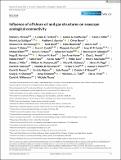Influence of offshore oil and gas structures on seascape ecological connectivity
Abstract
Offshore platforms, subsea pipelines, wells and related fixed structures supporting the oil and gas (O&G) industry are prevalent in oceans across the globe, with many approaching the end of their operational life and requiring decommissioning. Although structures can possess high ecological diversity and productivity, information on how they interact with broader ecological processes remains unclear. Here, we review the current state of knowledge on the role of O&G infrastructure in maintaining, altering or enhancing ecological connectivity with natural marine habitats. There is a paucity of studies on the subject with only 33 papers specifically targeting connectivity and O&G structures, although other studies provide important related information. Evidence for O&G structures facilitating vertical and horizontal seascape connectivity exists for larvae and mobile adult invertebrates, fish and megafauna; including threatened and commercially important species. The degree to which these structures represent a beneficial or detrimental net impact remains unclear, is complex and ultimately needs more research to determine the extent to which natural connectivity networks are conserved, enhanced or disrupted. We discuss the potential impacts of different decommissioning approaches on seascape connectivity and identify, through expert elicitation, critical knowledge gaps that, if addressed, may further inform decision making for the life cycle of O&G infrastructure, with relevance for other industries (e.g. renewables). The most highly ranked critical knowledge gap was a need to understand how O&G structures modify and influence the movement patterns of mobile species and dispersal stages of sessile marine species. Understanding how different decommissioning options affect species survival and movement was also highly ranked, as was understanding the extent to which O&G structures contribute to extending species distributions by providing rest stops, foraging habitat, and stepping stones. These questions could be addressed with further dedicated studies of animal movement in relation to structures using telemetry, molecular techniques and movement models. Our review and these priority questions provide a roadmap for advancing research needed to support evidence-based decision making for decommissioning O&G infrastructure.
Citation
McLean , D L , Ferreira , L C , Benthuysen , J A , Miller , K J , Schlappy , M-L , Ajemian , M J , Berry , O , Birchenough , S N R , Bond , T , Boschetti , F , Bull , A S , Claisse , J T , Condie , S A , Consoli , P , Coolen , J W P , Elliott , M , Fortune , I S , Fowler , A M , Gillanders , B M , Harrison , H B , Hart , K M , Henry , L-A , Hewitt , C L , Hicks , N , Hock , K , Hyder , K , Love , M , Macreadie , P I , Miller , R J , Montevecchi , W A , Nishimoto , M M , Page , H M , Paterson , D M , Pattiaratchi , C B , Pecl , G T , Porter , J S , Reeves , D B , Riginos , C , Rouse , S , Russell , D J F , Sherman , C D H , Teilmann , J , Todd , V L G , Treml , E A , Williamson , D H & Thums , M 2022 , ' Influence of offshore oil and gas structures on seascape ecological connectivity ' , Global Change Biology , vol. 28 , no. 11 , pp. 3515-3536 . https://doi.org/10.1111/gcb.16134
Publication
Global Change Biology
Status
Peer reviewed
ISSN
1354-1013Type
Journal item
Description
This research was supported by the National Decommissioning Research Initiative (NDRI Australia). We acknowledge the time contribution of all co-authors and additionally via research undertaken through the UKRI INSITE Programme including projects ANChor, CHASANS (NE/T010886/1), EcoConnect, EcoSTAR (NE/T010614/1), FuECoMMS (NE/T010800/1), MAPS, NSERC. DMP was supported through The Marine Alliance for Science and Technology for Scotland (MASTS) funded by the Scottish Funding Council and contributing institutions. SNRB and KH (Cefas) were funded by Cefas and the UK INSITE North Sea programme.Collections
Items in the St Andrews Research Repository are protected by copyright, with all rights reserved, unless otherwise indicated.

